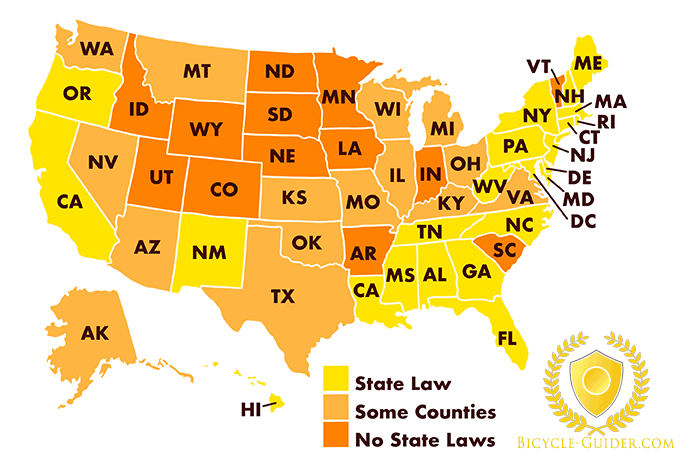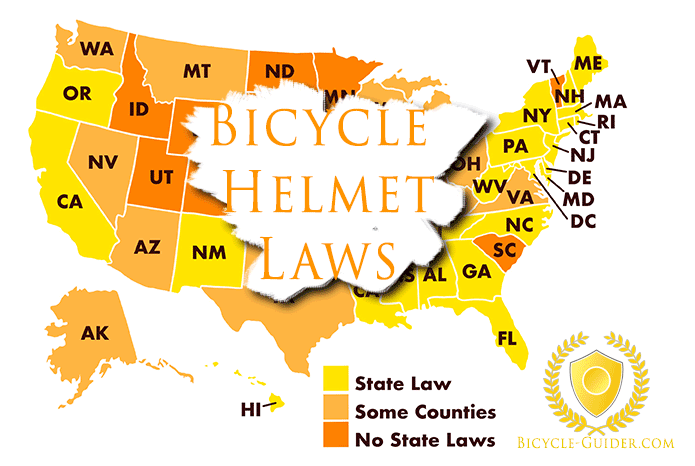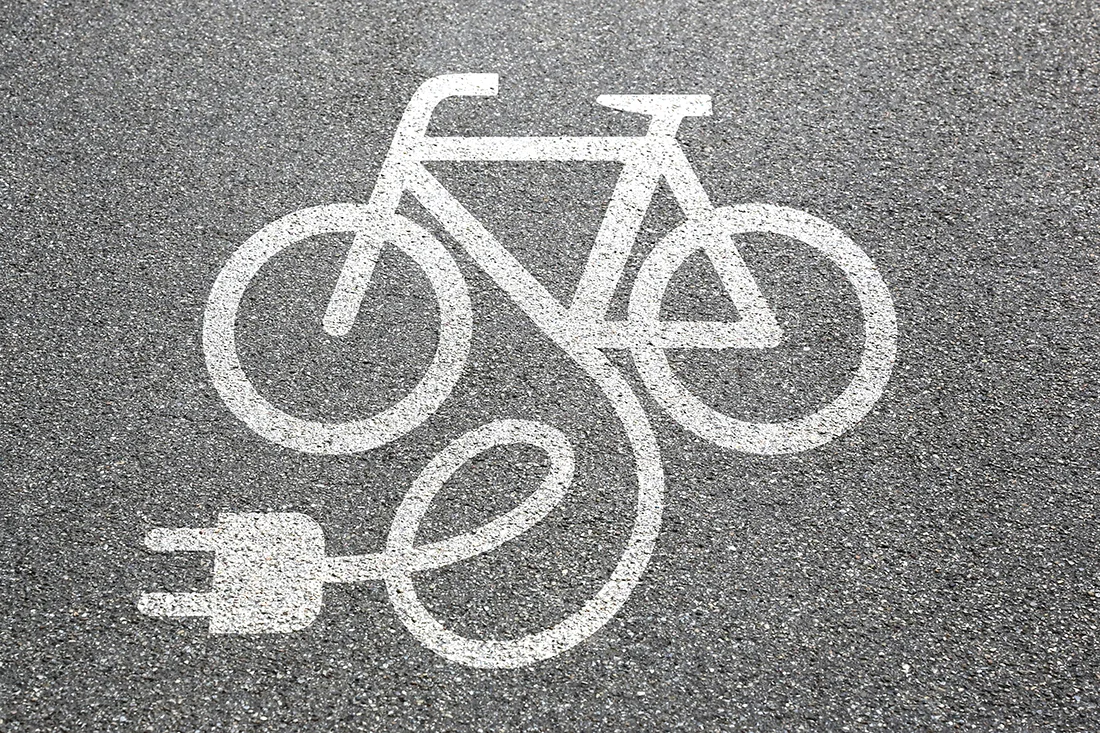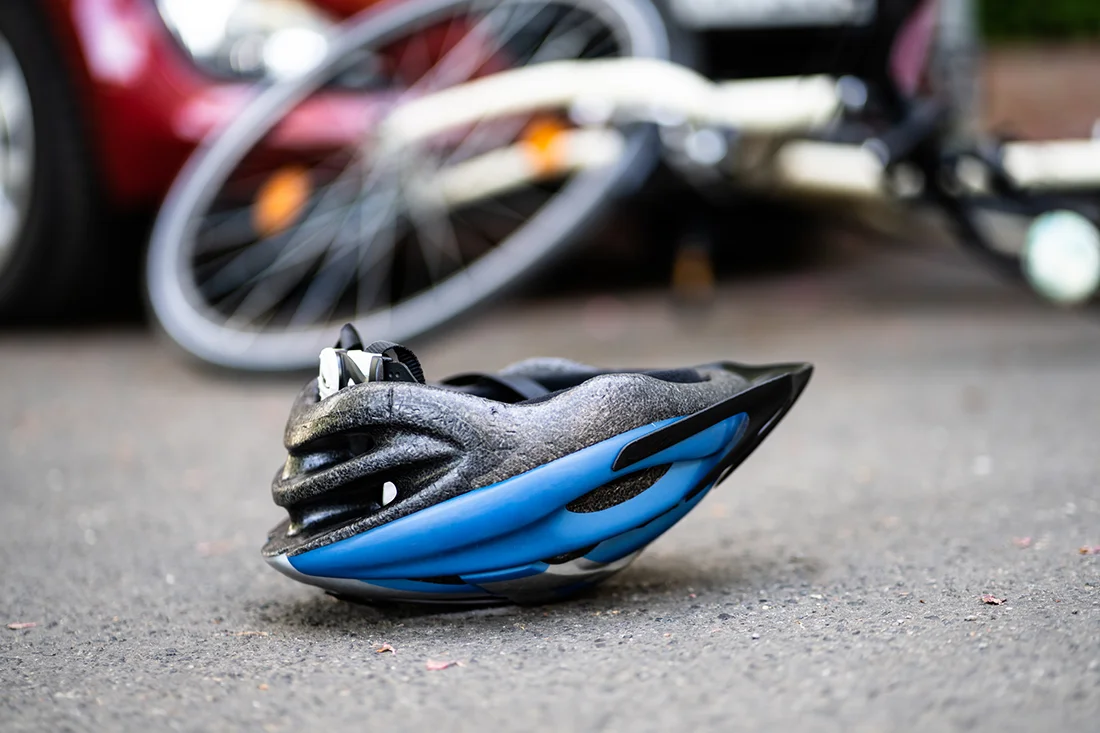Bicycle helmets are an important piece of safety equipment that can prevent serious head injuries and potentially save lives. But what do the laws and research around the world say about it? Let’s take an in-depth look.
Some countries require everyone by law to wear a helmet while riding a bicycle whereas others make it mandatory only for children and youth. However, most countries have no laws in place and let you decide what’s best for your noggin.
And what about in the U.S.? Are the California bicycle helmet law and Florida bicycle helmet law any different?
Who’s in the right here? We’ll try to answer this question by taking a closer look at the available data and research, as well as provide you with a detailed guide to bicycle helmet laws around the world.
Bicycle Helmet Laws
There’s no doubt that wearing a helmet significantly decreases your risk of serious head injury and thus has the potential to save your life.
However, countries that introduce mandatory bicycle helmet laws often see a large drop in the number of cyclists on the streets, which leads to increased morbidity that result from a sedentary lifestyle caused by reduced cycling.
Obviously, there’s no clear right or wrong in this situation, which is why most countries take a different approach. However, we recommend wearing a helmet whenever you go for a ride, even if it gives you the dreaded helmet hair.
World
Depending on where you live on this Pale Blue Dot, you might be required to wear a helmet at all times or just in certain situations. You might also be required to wear a helmet depending on how old you are and if you’re a passenger or a rider. Most commonly, though, you’ll be left to decide what’s best for yourself on your own.
Related: Bicycle Safety Facts, Tips & Rules
Here’s what the laws around the world have to say about bicycle helmet use.
- Albania: Not mandatory
- Argentina: Mandatory helmet use
- Australia: Helmets are mandatory
- Austria: Mandatory for U12
- Belarus: Not mandatory
- Belgium: Not mandatory
- Brazil: Helmets are not mandatory
- Bulgaria: Not mandatory
- Canada
- Mandatory: British Columbia, New Brunswick, Newfoundland and Labrador, Nova Scotia, and Prince Edward Island
- Mandatory for U18: Alberta, Manitoba, and Ontario
- Not mandatory: Northwest Territories, Nunavut, Quebec, Saskatchewan, and Yukon
- Chile: Mandatory in urban areas
- Costa Rica: Helmets are mandatory
- Croatia: Mandatory for U16 when riding on a road
- Czech Republic: Helmets are mandatory for U18
- China: Mandatory for e-bicycle riders
- Cyprus: Not mandatory
- Denmark: Not mandatory
- Estonia: Mandatory for U16 when riding on a road
- Finland: Not mandatory but recommended
- France: Mandatory for U12
- Germany: Not mandatory
- Hong Kong: Not mandatory
- Hungary: Helmets are not mandatory
- Iceland: Mandatory for U15
- India: Not mandatory
- Ireland: Not mandatory
- Israel: Mandatory for U18 and for adults only in city riding or in sport riding
- Italy: Not mandatory
- Japan: Mandatory for U13
- Latvia: Mandatory for U13
- Liechtenstein: Helmets are mandatory if riding faster than 20 kph
- Lithuania: Mandatory for U16
- Luxembourg: Not mandatory
- Malta: Mandatory for U10 when riding as a passenger
- Mexico: Not mandatory
- Monaco: Helmets are not mandatory
- Montenegro: Not mandatory
- Namibia: Mandatory
- New Zealand: Mandatory
- Netherlands: Not mandatory
- Poland: Helmets are not mandatory
- Portugal: Not mandatory except for e-bikes
- Romania: Helmets are not mandatory
- Russia: Not mandatory except for e-bikes with more than 250W motors
- Serbia: Not mandatory
- Singapore: Mandatory
- Slovakia: Mandatory for U15
- Slovenia: Helmets are mandatory for U14
- South Africa: Mandatory
- South Korea: Not mandatory
- Spain: Mandatory for U16 at all times and for all cyclists out of city centers
- Sweden: Mandatory for U15
- Switzerland: Helmets are mandatory on bikes and e-bikes going faster than 25 kph
- UAE: Mandatory in Dubai
- Ukraine: Not mandatory
- United Kingdom: Not mandatory
- Uruguay: Mandatory
USA
The United States of America is a federal republic that consists of 50 states, each of which has the right to pass its own laws regarding different issues.
As a result, helmet laws by state differ from one state to another. In some states, all ages are required to wear a helmet, others make it mandatory only for certain ages, whereas some states don’t bother making bicycle helmet use mandatory.
Here are bicycle helmet laws by state in the USA, so you’ll know exactly what’s expected from you when you cross state borders.

In order to get a clearer overview of the different bicycle helmet laws by state, head over to Helmets.org.
Recent Studies Related to Bicycle Helmet Use
- A Case-Control Study of the Effectiveness of Bicycle Safety Helmets – This study found that riders who wore helmets had an 85 percent reduction in their risk of head injury and an 88 percent reduction in their risk of brain injury. It concluded that bicycle safety helmets are highly effective in preventing head injury.
- The Health Impact of Mandatory Bicycle Helmet Laws – According to this study, the negative health impact of reduced cycling rates caused by mandatory helmet use outweighs the benefits that helmets provide. Piet de Jong calculated that an overall net cost to public health of a mandatory helmet law would be about £500m a year in the UK.
- More Cyclists In A Country Means Fewer Fatal Crashes – Statistics show that as the number of cyclists in a country goes up, the number of deaths related to cycling trips go down.
- Safety in numbers: more walkers and bicyclists, safer walking and bicycling – A study conducted by P L Jacobsen suggests that motorists are less likely to collide with a person walking or bicycling if more people walk or bicycle. Therefore, increasing the number of people walking or cycling is the most effective way to improve the safety of those people.
- Mandatory bicycle helmet use following a decade of helmet promotion in Victoria, Australia – An evaluation study showing a decrease in the number of insurance claims for bicyclists killed or admitted to hospital following a head injury, as well as a decrease in the number of bicyclists killed or admitted to hospital after the introduction of mandatory helmet use in Australia in 1990.
- Bicycle helmet efficacy: a meta-analysis – A meta-analysis that shows clear evidence that bicycle helmets prevent serious injury and even death, but lead to an increase of neck injuries.
- Publication bias and time-trend bias in meta-analysis of bicycle helmet efficacy – A 2011 re-examination of the study above by Rune Elvik that shows the overall protection alleged by the original study could be slightly reduced given what seems to be an increase in the likelihood of a neck injury if you wear a helmet.
- Wearing A Helmet Puts Cyclists At Risk – Research suggests cyclists who wear helmets are more likely to be struck by passing vehicles as drivers pass closer when overtaking cyclists with helmets.
- Bicycle Helmet Wearing Is Not Associated with Close Motor Vehicle Passing – A reanalysis of the study listed above concludes that wearing a helmet is not, in fact, associated with close motor vehicle passing.
- Wearing a Bicycle Helmet Can Increase Risk-Taking and Sensation Seeking in Adults – A study that suggests that cyclists are more likely to engage in risky behavior while wearing a helmet as opposed to riding bareheaded.
- Evaluation of New Zealand’s bicycle helmet law – A New Zealand survey data shows the average hours cycled dropped by 50% for the period 1989-1990 to 2006-2009, following the introduction of mandatory bicycle helmet use.
- Jersey Scrutiny review: Compulsory wearing of cycle helmets – A report that found that the year before the introduction of mandatory bicycle helmet use on Jersey Island, 84% of Jersey children wore helmets anyway, and not a single under-14 had been seriously hurt on a bike.
- No clear evidence from countries that have enforced the wearing of helmets – A 2006 study shows that before and after data indicates enforced helmet laws discourage cycling but produce no obvious response in the percentage of head injuries.
- Bicycle helmets: review of effectiveness – The USA Department of Transport report concludes there is little evidence that helmets complying with one standard as opposed to another perform better in protecting the wearer in the event of a crash. Therefore, your helmet should meet one of the standards they list, but it doesn’t matter which.
- The efficacy of bicycle helmets against brain injury – An evaluation that concludes that bicycle helmets prevent serious injury, to the brain in particular.
- Bicycle injuries and helmet use: a systematic review and meta-analysis – A meta-analysis of the available evidence that suggests bicycle helmet use was associated with reduced odds of head injury, serious head injury, facial injury, and fatal head injury.
- 2.4 million Australians put off their bikes by helmet laws – Research shows 16.5% of Australians say they would ride more often if they were not required to wear a helmet at all times.
- Bike helmets greatly reduce the risk of head injuries – Research done by VicRoads shows that bicycle helmets reduce the chances of a serious head injury by almost 70%.
- Helmet use and bicycle-related trauma injury outcomes – A study showing that bicycle helmet use may reduce injury severity, Hospital Length Of Stay, ICU Length Of Stay, and mortality.
- Bicycle helmets work when it matters the most – A 2016 study that concludes bicycle helmet use provides protection against severe TBI, reduces facial fractures, and saves lives even after sustaining an intracranial hemorrhage.
- Prevalence of Sports-related Head Injuries – A report that shows cycling contributes to the highest number of estimated head injuries treated in US hospitals in 2018.
- Pros and cons regarding bicycle helmet legislation – An article written by the European Union’s Mobility and Transport office regarding the pros and cons of bicycle helmet laws.
- Helmet Laws: creating consensus from controversy and contradictions – A paper that discusses bicycle helmet laws in the context of the benefits and drawbacks of legislation and the effort spent promoting them compared to other more effective measures.
- Systematic reviews of bicycle helmet research – A review of three bicycle helmet studies evaluating the effects of bicycle helmet use and bicycle helmet laws on the prevention of serious cycling-related head injuries.
- A meta-analysis of the effects of bicycle helmets on injuries – A meta-analysis that concludes the use of bicycle helmets was found to reduce head injury by 48%, serious head injury by 60%, traumatic brain injury by 53%, face injury by 23%, and the total number of killed or seriously injured cyclists by 34%.
- Bicycle helmets and risky behaviour: A systematic review – A meta-analysis showing that there is no clear evidence that people who wear bike helmets engage in more risky behaviors while riding their bicycles.
- Why Helmets Aren’t the Answer to Bike Safety – Cyclist’s helmet use and fatality rate by country.
- Evaluating the impact of cycle helmet use on severe traumatic brain injury and death – This study suggests that there is a significant correlation between the use of cycle helmets and reduction in adjusted mortality and morbidity associated with TBI and facial injury.
FAQ
Can I ride my bicycle without a helmet?
The correct question to ask is should you ride a bike without a helmet. The answer is no, you shouldn’t. A helmet will protect your head and brain from serious injury in case of crash, which can happen at any time. Even if you are just cruising down a cycle path at low speeds, accidents can happen and you can end with serious consequences if your ride bareheaded.
Do bicycle helmets really work?
Yes, bicycle helmets really work. Studies upon studies have shown that bicycle helmets protect the head and the brain from serious injury in case of a crash. Just ask yourself would you prefer crashing with or without a helmet on your head and you’ll have the answer.
Are bike helmets really necessary?
It depends on whom you ask. However, the majority of experts and studies have come to the conclusion that bike helmets are an important layer of protection in case of a crash. Therefore, even if some might argue that helmets are not necessary, it’s a good idea to have one on your head in case you get into an accident.
Is it OK to bike without a helmet?
No, it is not OK to bike without a helmet. In most countries around the world, wearing a helmet is not mandatory and you won’t be fined for cruising around bareheaded. However, cycling without a helmet is not a good idea as your head and brain can sustain serious injury if you fall.
Is it illegal to ride a bike without a helmet in Canada?
It depends on where you live/ride in Canada. Some provinces require all ages to wear a helmet, some make it mandatory only for U18, whereas others do not require anyone to wear a helmet by law.
Which states have no helmet laws?
Most states in the USA have helmet laws that require some ages or all ages to ride with a helmet at all times or in certain situations. For a more detailed look, take a look at the information we’ve provided above.
What is a bicycle helmet made of?
All bicycle helmets are made of four crucial parts: Shell, liner, internals, and straps. The shell is usually made of thin plastic whereas the liner is made from expanded polystyrene (EPS) foam. Depending on how much money you spend, you might also get some carbon fiber parts and additional technologies such as MIPS.
Are bike helmets actually safer?
Yes, it is a lot safer to ride with than without a bicycle helmet. If you crash and hit your head on a hard surface, a bike helmet will protect you from serious consequences such a concussion or skull fracture.
Why do bikers not wear helmets?
Some people refuse to wear a helmet either because they are misinformed on how effective helmets are at protecting the head and brain or because they think bicycle helmets are not cool. For some people, bicycle helmets seem like an expensive investment that they will likely never need as they’ve never crashed. All of these are wrong ways to think about bike helmets — wear one at all times!
Why should you not wear a helmet?
There are no reasons why you should not wear a helmet and plenty of reasons to wear one at all times. If you think a bike helmet will ruffle your haircut, think about what concrete will do to it.
Why are bike helmets so expensive?
Bike helmets are expensive because of the amount of time, research, and resources that go into their development. Bicycle helmets don’t use expensive materials but they use advanced technologies that require a highly skilled workforce to develop. Each helmet must also pass extensive testing which again takes a lot of time and resources.
Do helmets prevent brain injury?
Yes, helmets prevent brain injury, there are numerous studies that prove it. Of course, head injury is still possible even if you wear a helmet, but it is much less likely to happen. If you wear a properly fitted helmet and you wear it correctly, you are much more likely to walk away from an accident with your head in one piece.
Do bike helmets expire?
Yes, bike helmets do expire. Most helmet manufacturers recommend that you replace a helmet after five years of use. The materials helmets are made of might change their properties because of UV radiation, weather elements, small impacts, and so on.
What is the lifespan of a bike helmet?
Most manufacturers recommend that you replace a helmet after five years. Also, if you get into a crash and your helmet sustains an impact, make sure to replace it. Even if the helmet looks OK, it might have small cracks that you can’t see but that will greatly affect its performance and the level of protection it provides.
What is the safest bicycle helmet?
There isn’t one definitive answer to this question. All bicycle helmets that are made according to safety standards and are worn properly on the head are safe. However, spending more money and getting a helmet with MIPS or other technologies will make a helmet even safer.
How important is MIPS in a bike helmet?
MIPS stands for Multi-directional Impact Protection System. It is an additional movable layer inside the helmet that protects your head from rotational forces upon impact. Research has shown that MIPS reduces brain injury and provides better protection compared to a helmet without MIPS.
Which color helmet is best?
There isn’t one best helmet color that you should choose. However, it goes without saying that bright colors will make you more visible, so it’s a good idea to go for white, yellow, or orange helmets if you want the best chance to be seen from afar.
Are white helmets cooler?
In theory, white helmets should be cooler than black ones. However, in practice, they’re not. The reason is that the liner that sits between the shell and your head serves as an excellent insulator. What makes one helmet cooler than another is the number of vents it has and their positioning.
How tight should a helmet fit?
A helmet should be nor too tight nor too loose. It should sit snuggly on your head, but you should not feel that it’s pressing your head. Also, you should be able to fit a finger between the straps and your chin, so the straps are not choking you, but they also shouldn’t be dangling freely around.
How many people die from not wearing helmets?
According to NCS, 54% of cyclists killed in 2015 (42) were not wearing a helmet. The same is true for the year 2016 (424) as well.
What happens if you don’t wear a helmet?
If you don’t wear a helmet, you greatly increase your chances of suffering a brain injury if you crash. If your head hits the ground, even at low speeds, you’re more likely to have a concussion, contusion, or fractured skull if you’re not wearing a helmet.
How can I look cool on a bike?
If you ask me, one of the best ways to look cool on a bike is to wear a helmet. If I see you on the road with a helmet on your noggin, I’ll give you a thumbs up and a nod of approval.
Resources
- http://servicios.infoleg.gob.ar/infolegInternet/anexos/0-4999/818/texact.htm
- https://nt.gov.au/driving/safety/bicycle-safety
- https://www.danube-cycle-path.com/bike-helmet-laws.html
- https://www.fietsersbond.be/fietshelm
- https://www.scielo.br/scielo.php?script=sci_arttext&pid=S1415-790X2013000400918#B23
- http://www.cycle-helmets.com/canada_helmets.html
- https://andesproperty.com/blog/2015/01/22/bicycling-laws-santiago-chile/
- https://nuevaleydetransito.com/articulo/119/Obligaciones-de-los-ciclistas
- https://narodne-novine.nn.hr/clanci/sluzbeni/2011_07_74_1575.html
- https://news.expats.cz/weekly-czech-news/pragues-police-cycle-team-will-give-advice-not-fines-to-bikers-this-summer/
- https://www.donkey.bike/denmark-cycling-rules/
- https://www.sciencedirect.com/science/article/abs/pii/S1369847818300810
- https://www.legifrance.gouv.fr/affichCodeArticle.do?cidTexte=LEGITEXT000006074228&idArticle=LEGIARTI000033667568&dateTexte=&categorieLien=cid
- https://www.thelocal.de/20161207/should-germans-be-made-to-wear-bike-helmets-cycling-germany-australia
- https://www.scmp.com/news/hong-kong/law-crime/article/2139681/if-youre-riding-bike-next-week-hong-kong-police-will-be
- https://www.globaltimes.cn/content/1187557.shtml
- https://dailynewshungary.com/tips-and-tricks-for-riding-a-bike-in-budapest/
- http://www.islandia.is/lhm/english.htm
- https://www.citizensinformation.ie/en/travel_and_recreation/cycling/cycling_offences.html
- http://www.israelishortcut.org/Services.aspx?l=2&c=3&id=1126
- https://www.welovecycling.com/wide/2015/04/04/stay-well-equipped-across-europe/
- https://okinawa.stripes.com/community-news/hey-bikers-you-really-need-pay-attention-japan-seriously
- https://www.maltatoday.com.mt/news/national/83873/bicycle_helmet_use_to_become_optional_under_new_legislation
- https://www.eltis.org/discover/news/mexico-city-abolishes-bike-helmet-law-mexico-0
- http://www.nampol.gov.na/documents/139923/140403/NATIONAL+FINE+LIST.pdf/7fea7eea-8d1c-4938-986a-8f64b60463f1
- https://injuryprevention.bmj.com/content/8/4/317
- https://www.holland-cycling.com/index.php/tips-and-info/safety/traffic-rules-and-regulations-for-cyclists
- https://polandonbike.com/safety-in-poland/
- https://road.cc/content/news/221700-portugal-bins-compulsory-helmet-law-plan-face-public-reaction
- https://www.todayonline.com/singapore/new-rules-cyclists-personal-mobility-device-users-and-motorists-kick-feb-1
- https://www.sloveniaestates.com/life-in-slovenia/cycling-in-slovenia
- https://www.arrivealive.co.za/Cycling-Helmets-and-Cycling-Safety
- https://www.koreatimes.co.kr/www/nation/2018/10/281_256283.html
- https://blog.abacoadvisers.com/cycle-helmet-laws-in-spain/
- https://www.donkey.bike/sweden-cycling-rules/
- https://www.publibike.ch/en/publibike/how-it-works/security/
- https://www.edarabia.com/7-common-cycling-rules-in-the-uae/
- http://www.cycle-helmets.com/england_helmets.html
- https://www.who.int/violence_injury_prevention/road_safety_status/2009/laws/helmet_uruguay_en.pdf
- https://www.uio.no/english/about/jobs/ismo/while-in-oslo/getting-around/bicycle-rules.html
- https://trip.studentnews.eu/s/4086/77078-Safety-helmet-in-Europe.htm?c1_1=27359
- https://www.easst.co.uk/pre-school-children-minsk-practice-safe-cycling/
- https://trip.studentnews.eu/s/4086/77078-Safety-helmet-in-Europe.htm?c1_1=27334
- https://luxtimes.lu/archives/6368-8-things-a-bike-should-have-in-luxembourg
- https://www.idealo.co.uk/magazine/2016/09/25/i-wear-bike-helmet/
- https://trip.studentnews.eu/s/4086/77078-Safety-helmet-in-Europe.htm?c1_1=27351
- https://monabike.mc/en/faq
- https://nacto.org/wp-content/uploads/2015/07/2012_de-Jong_Health-Impacts-of-Mandatory-Bicycle-Helmet-Laws.pdf
- https://www.nsc.org/safety-first-blog/bicycle-safety-statistics-may-surprise-you




